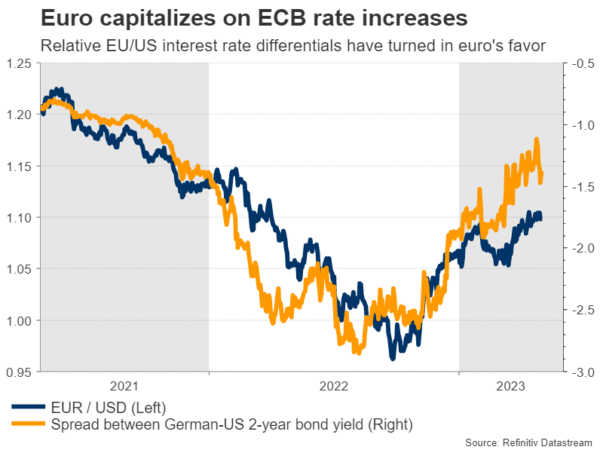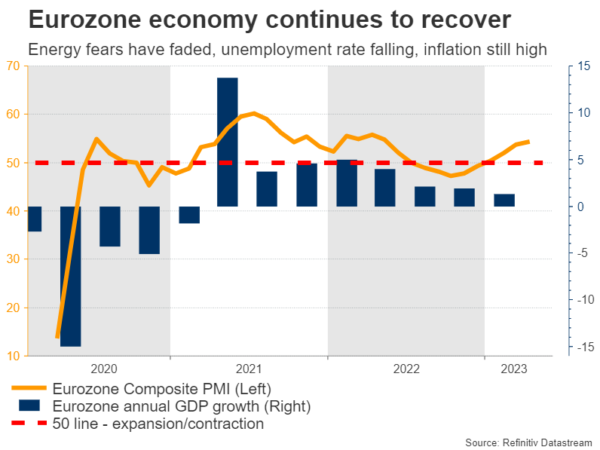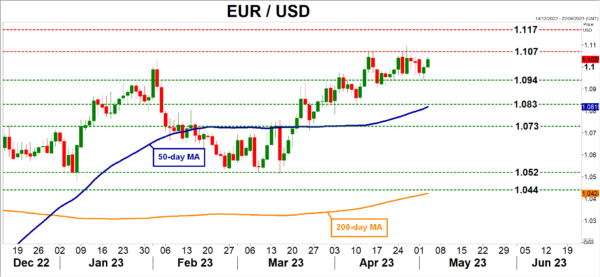All eyes will be on the European Central Bank rate decision on Thursday at 12:15 GMT. A rate increase is all but certain, yet its size is still up for debate. Market pricing is leaning towards 25bps, but some traders are still betting on a bigger 50bps move. The compromise might be the smaller rate hike accompanied by hawkish language, which could take some steam out of the high-flying euro.
Euro shines bright
The euro has been among the best-performing major currencies this year, as most of the negative factors that haunted the single currency last year have either eased or vanished. Europe got through the winter without suffering a recession, energy prices have fallen sharply, China has reopened, and most importantly the ECB has come a long way in raising interest rates.
One of the euro’s main disadvantages over the last decade was the ECB’s negative interest rate policy, which made the Eurozone unattractive as an investment destination. This has changed dramatically, with ECB rates currently standing at 3% and market pricing projecting them to go as high as 3.6% in this cycle.
But it’s not just interest rates, as the euro area is also enjoying a burst of economic momentum. Business surveys point to an economy that is accelerating, inflation continues to rage with support from consumer demand, and the strength in the labor market has helped fuel wage growth.
ECB conundrum
Turning to the upcoming rate decision, investors are leaning towards a smaller rate increase of 25bps, assigning this scenario an implied probability of around 80%. The alternative is for a bigger move of 50bps, which markets have attached a 20% probability to.
If the decision was only based on the quality of economic data releases, there is a serious case for the ECB to raise by 50bps. Economic growth remains resilient, core inflation has been stickier than expected, while the declining unemployment rate and strengthening wage dynamics are not consistent with inflation falling back to its target anytime soon.
However, there are two issues that might make the ECB cautious. Firstly, the recent turbulence in the banking system argues for slower loan growth, which as the Fed argued recently, has similar effects to raising rates. Secondly, the full impact of previous rate increases hasn’t been felt yet, so some ECB members might be wary of overdoing it, and inflicting unnecessary damage on the economy.
As per usual, the decisions of the ECB Governing Council are taken through compromise, given the different views among its members. In this case, a middle-of-the-road solution may be to raise rates by 25bps, but accompany that move with hawkish language hinting at more rate increases in future meetings.
Market reaction
Considering how markets have priced this decision, such an outcome might be slightly bearish for the euro. It would signal the ECB has started to get cold feet, likely giving rise to speculation that the end of the tightening cycle is imminent. In this scenario, euro/dollar could edge lower, with the first obstacle for the bears likely to be the 1.0940 zone.
On the other hand, if the ECB rolls out a 50bps rate increase, that would come as a surprise for investors and the euro will likely enjoy further upside. In euro/dollar, such a move might propel the pair above the 1.1070 region, which capped multiple advances in recent weeks.
All told, the pair has been in an uptrend for more than half a year now, although a clear close above 1.1070 is required to signal trend continuation.
Note that the Federal Reserve will also announce its own rate decision on Wednesday, ahead of Thursday’s ECB meeting, and could also impact euro/dollar.















